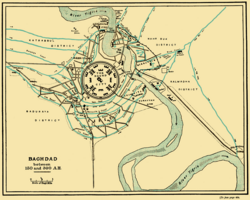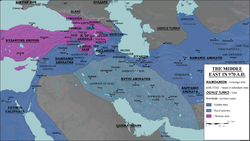Abbasid Caliphate
The Abbasid Caliphate[2] was the third Arab Islamic caliphate. It overthrew the Umayyad caliphs from all but Al-Andalus. It was built by the descendant of Muhammad's youngest uncle, Abbas ibn Abd al-Muttalib. It was created in Harran in 750 of the Christian era and shifted its capital in AD 762 from Harran to Baghdad. It flourished for two centuries, surviving the Zanj Rebellion (869-883). Abbasid rule was ended in 1258, when Hulagu Khan, the Mongol conqueror, sacked Baghdad. But they continued to claim authority in religious matters from their base in Egypt.
Abbasid Caliphate اَلْخِلَافَةُ ٱلْعَبَّاسِيَّةُ | |||||||||||||||||||||||||
|---|---|---|---|---|---|---|---|---|---|---|---|---|---|---|---|---|---|---|---|---|---|---|---|---|---|
| |||||||||||||||||||||||||
 Abbasid Caliphate at its greatest extent, c. 850 | |||||||||||||||||||||||||
| Status |
| ||||||||||||||||||||||||
| Capital | |||||||||||||||||||||||||
| Common languages | Classical Arabic (central administration); various regional languages | ||||||||||||||||||||||||
| Religion | Sunni Islam | ||||||||||||||||||||||||
| Government | Caliphate | ||||||||||||||||||||||||
| Caliph | |||||||||||||||||||||||||
• 750–754 | As-Saffah (first) | ||||||||||||||||||||||||
• 1242–1258 | Al-Musta'sim (last Caliph in Baghdad) | ||||||||||||||||||||||||
• 1508–1517 | al-Mutawakkil III (last Caliph in Cairo) | ||||||||||||||||||||||||
| History | |||||||||||||||||||||||||
• | 750 | ||||||||||||||||||||||||
• | 1517 | ||||||||||||||||||||||||
| Currency | |||||||||||||||||||||||||
| |||||||||||||||||||||||||
During the period of the Abassid dynasty, Abassid claims to the caliphate did not go unchallenged. The Shiˤa Ubayd Allah al-Mahdi Billah of the Fatimid dynasty, which claimed descendency of Muhammad through his daughter, claimed the title of Caliph in 909 and created a separate line of caliphs in North Africa. Initially it covered only Morocco, Algeria, Tunisia and Libya, but then the Fatimid caliphs extended their rule for the next 150 years, taking Egypt and Palestine and even ancient Pakistan, before the Abbassid dynasty was able to turn the tide, limiting Fatimid rule to Egypt. The Fatimid dynasty finally ended in 1171. The Umayyad dynasty, which had survived and come to rule over the Muslim provinces of Spain, reclaimed the title of Caliph in 929, lasting until it was overthrown in 1031.
The tenth caliph, Al-Mutawakkil, is the person who oversaw the introduction of hadiths.[3]
Abbasid Caliphate Media
Plan of Baghdad between 767 and 912 CE, according to William Muir
Harun al-Rashid (r. 786–809) receiving a delegation sent by Charlemagne at his court in Baghdad. Painting by Julius Köckert (1827–1918), dated 1864. Oil on canvas.
Gold dinar minted during the reign of al-Amin (809–813)
Partly-reconstructed remains of a courtyard with circular pool in the Dār al-Khilāfa, the caliph's palace, in Samarra, begun in 836.
The walls and spiral minaret of the Great Mosque of Samarra, built from 848 to 852 CE in the Abbasid capital of Samarra
The Middle East c. 970, after the Abbasids came under the control of the Buyid dynasty
Related pages
Notes
- ↑ The Abbasid Revolution against the Umayyad Caliphate adopted black for its rāyaʾ for which their partisans were called the musawwids. Tabari (1995), Jane McAuliffe (ed.), Abbāsid Authority Affirmed, vol. 28, SUNY, p. 124 Their rivals chose other colours in reaction; among these, forces loyal to Marwan II adopted red. Patricia Crone (2012). The Nativist Prophets of Early Islam. p. 122. ISBN 9781107018792.. The choice of black as the colour of the Abbasid Revolution was already motivated by the "black standards out of Khorasan" tradition associated with the Mahdi. The contrast of white vs. black as the Umayyad vs. Abbasid dynastic colour over time developed in white as the colour of Shia Islam and black as the colour of Sunni Islam: "The proselytes of the ʿAbbasid revolution took full advantage of the eschatological expectations raised by black banners in their campaign to undermine the Umayyad dynasty from within. Even after the ʿAbbasids had triumphed over the Umayyads in 750, they continued to deploy black as their dynastic colour; not only the banners but the headdresses and garments of the ʿAbbasid caliphs were black ... The ubiquitous black created a striking contrast with the banners and dynastic color of the Umayyads, which had been white ... The Ismaili Shiʿite counter-caliphate founded by the Fatimids took white as its dynastic color, creating a visual contrast to the ʿAbbasid enemy ... white became the Shiʿite color, in deliberate opposition to the black of the ʿAbbasid 'establishment'." Jane Hathaway, A Tale of Two Factions: Myth, Memory, and Identity in Ottoman Egypt and Yemen, 2012, p. 97f. After the revolution, Islamic apocalyptic circles admitted that the Abbasid banners would be black but asserted that the Mahdi's standard would be black and larger. David Cook (2002). Studies in Muslim Apocalyptic, p. 153. Anti-Abbasid circles cursed "the black banners from the East", "first and last". Patricia Crone (2012). The Nativist Prophets of Early Islam. p. 243. ISBN 9781107018792.
- ↑ Abbasid (Arabic: لعبّاسيّون, transcription al-‘Abbāsīyūn) is the dynastic name generally given to the caliph of Baghdad
- ↑ History of al-Tabari Vol. 34, The: Incipient Decline, page 149
Other websites
- Abbasids (750-1517) Archived 2008-02-24 at the Wayback Machine
- Abbasids the 2nd dynasty of caliphs Archived 2019-07-13 at the Wayback Machine
- Abbasid Caliphs (In Our Time, Radio 4), in Streaming RealAudio
- An On-Going Detailed Account of the History of the Abbasids from an Islamic perspective. Most of the narrations have been sifted through to avoid "biased" theories regardless if the historians as mentioned are Shiite or Sunni.
- Abbasid Caliphate Archived 2008-04-03 at the Wayback Machine entry in Encyclopaedia Iranica Archived 2008-07-12 at the Wayback Machine









